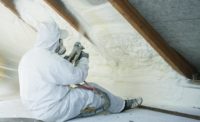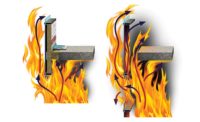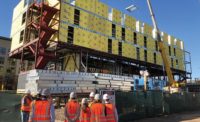United States demand for insulation is forecasted to rise 3.7 percent per year to approximately $9.5 billion by 2021. Advances will be driven by:
- Rising adoption of more stringent building codes such as the International Energy Conservation Code;
- Efforts to improve energy efficiency by adding or replacing insulation in both residential and commercial structures;
- Increasing interest in green building practices;
- Strong growth in housing starts, particularly in the single-family housing market.
Fiberglass & Foamed Plastics Driving the Market
Fiberglass will remain the leading product category as construction professionals and DIYers continue to favor the material for its low cost, good insulative properties and ease of installation.
Demand for foamed plastic (spray foam) will rise primarily on gains in the commercial building market, where use of this material predominates due to its high R-values. Sales of spray foam are also expected to rise in the residential market, due in part to more stringent building codes calling for improved insulation in homes—a major focus of the IECC. Despite its higher cost, homeowners will increasingly specify spray foam for its ability to seal between walls and hard-to-reach areas such as crawl spaces.
Through 2021, batts and blankets will remain the dominant fiberglass insulation product form, reaching 2.8 billion pounds on annual growth of 2.6 percent. The widespread use of fiberglass batts and blankets is the result of:
- Cost effectiveness in terms of R-value achieved relative to material and installation costs;
- Ease of installation;
- The familiarity of these products to homeowners and construction professionals.
Demand for loose fill product forms will rise 3.5 percent per year to 1.1 billion pounds through 2021, due in part to their suitability in sealing gaps and other hard to reach places as homeowners continue to insulate more areas of their homes.
Rigid boards account for a much lower share of the market than batts, blankets and loose fill insulation since rigid fiberglass board insulation is used primarily in non-residential building construction and for industrial and HVAC applications.
The other product forms category includes sill sealers, water heater and pipe jackets as well as specialty pipe and duct wraps. Growth will be aided by continued efforts to improve energy efficiency in both the residential and commercial markets by adding insulation in certain areas such as around water heaters and air ducts. However, stronger gains will be restricted by the higher costs of these products forms, particularly specialty products, compared to batts, blankets, loose fill and rigid boards.
Mineral Wool Expected to Post Robust Gains
Mineral wool will record the fastest sales increases through 2021. This is due to its ability to withstand extreme temperatures as fire safety codes continue to become more stringent for all markets. Also supporting gains is the material’s effectiveness as acoustical insulation for interior walls and the increased use in industrial and HVAC equipment applications.
Demand for mineral wool batts and blankets is projected to increase 5.1 percent per annum to 510 million pounds in 2021. Mineral wool batt and blanket demand will be supported by the increasing popularity of these product forms in the residential market due to their acoustic properties and more stringent fire codes in commercial buildings.
Mineral wool batts and blankets are often used in structures as alternatives to fiberglass insulation; however, competition from foamed plastics will serve as a check on demand growth.
Demand for loose fill mineral wool insulation is expected to expand 4.8 percent annually to 297 million pounds in 2021. Gains will be fueled by strong growth in single-family housing as homebuilders specify loose fill for attic applications. Loose fill materials are also used in the commercial market. The flame resistance and sound-dampening properties of the materials make them suitable for such structures as hospitals, schools, airports and shopping centers.
Residential Markets to be Fastest Growing
The residential market will post the most rapid gains through 2021. While the bulk of insulation demand will be due to the increased number of new dwellings, additional gains will arise from the installation of more insulation per new structure as more U.S. areas begin to comply with recent IECC mandates. Residential insulation demand will also be supported by efforts to upgrade insulation in existing houses, as homeowners seek to reduce utility bills by retrofitting the insulation in their attics and walls to increase energy efficiency.
Through 2021, value demand for insulation used in residential buildings is expected to rise 4.8 percent per annum to $3.6 billion in 2021, the fastest rate of increase of any major market.
The increasing demand will be supported by:
- Strong growth in single-family housing starts;
- Rising interest in attic re-insulation projects to improve energy efficiency;
- Increasing adoption of more stringent building codes in several states.
However, growth will be restrained by:
- Weak growth in multifamily housing starts and manufactured housing shipments;
- Single-family houses decreasing in average size.








Report Abusive Comment